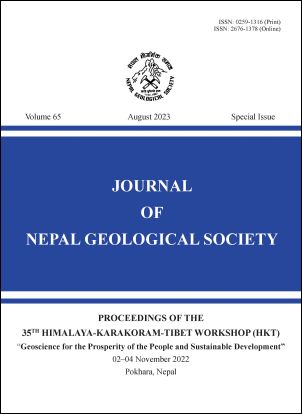An overview of Rodinia-Gondwana Supercontinents, India - Asia Collision, emergence of Himalaya and Paleobiogeography of the eastern Tethys in Indian Subcontinent, South Asia
DOI:
https://doi.org/10.3126/jngs.v65i01.57740Keywords:
Gondwana supercontinent, Himalaya, paleobiogeography, south AsiaAbstract
The existence of Rodinia Supercontinent during Meso-Neoproterozoic and its subsequent breakup and reassembly as Gondwana Supercontinent is a widely accepted hypothesis in geological history of the Earth. The breakup of the Rodinia resulted in formation of rift basins and passive continental margins around 650 Ma. Major palaeoclimatic events like Neoproterozoic global glaciation (Snowball Earth) followed by global warming have been recorded from different continents including Indian Lesser Himalaya (Blaini -Krol Cryogenian-Ediacaran Period). The emergence of multicellular Ediacaran life in the Upper Krol Formation is consistent with an increase in the atmospheric oxygen. The base of Ediacaran System in the Lesser Himalaya is established in the cap carbonate, the Blaini Formation overlying the glacial diamictites (Blainian). The pink cap carbonate of the Blaini Formation shows negative δ13C value (-3‰ PDB) and invariably correlate with the Marinoan glacial event. Large continents of Gondwanaland Supercontinent South America, Africa, India, Australia and Antarctica were located over the South Polar region and global equatorial to polar oceanic circulation was blocked and may have been the main cause of glaciation. Paleogeographically Carboniferous–Permian diamictite, coal beds and plant fossil bearing Gondwana outcrops are found in South Sikkim and Arunachal Lesser Himalaya of Northeast India. The Late Paleocene – Middle EoceneTethyan foraminiferal – algal carbonate biofacies are well developed after Late Cretaceous – Paleogene mass extinction event in the eastern Tethys, Meghalaya, east India. These Tethyan benthic orthophragmine foraminiferal –algal limestones were deposited in the passive continental margin setting of a shallow marine carbonate shelf in eastern Tethys and Standard Benthic Zones (SBZ) of the Alpine- Adriatic western Tethys are recorded from Meghalaya. The Cretaceous – Tertiary boundary is well marked in these basins by biotic mass extinction. Late Cretaceous mega ammonoid fossils and Sauropod dinosaur bones are abundantly found in the Maastrichtian Mahadeo Formation. The present δ13C and δ18O isotope data is comparable with the marine values of the limestone The Umlatodoh Limestone contains foraminiferal taxa of early Ilerdian and Middle Eocene (early Lutetian) age. The Indo-Myanmar Orogenic Belt (IMOB) represents the eastern suture of Indian plate and it was formed due to the collision of the Indian plate with the Myanmar plate. The Naga-Manipur ophiolites have been assigned to range in age from Upper Cretaceous to Eocene on the basis of faunal assemblages (radiolarian, planktonic foraminefera) in the olistolithic blocks of pelagic limestone and cherts. Pan Indian Pre and Post India–Asia Collision, emergence of Himalaya and Paleogeography of the Indian Subcontinent has been discussed in South Asia.
Downloads
Downloads
Published
How to Cite
Issue
Section
License
© Nepal Geological Society




